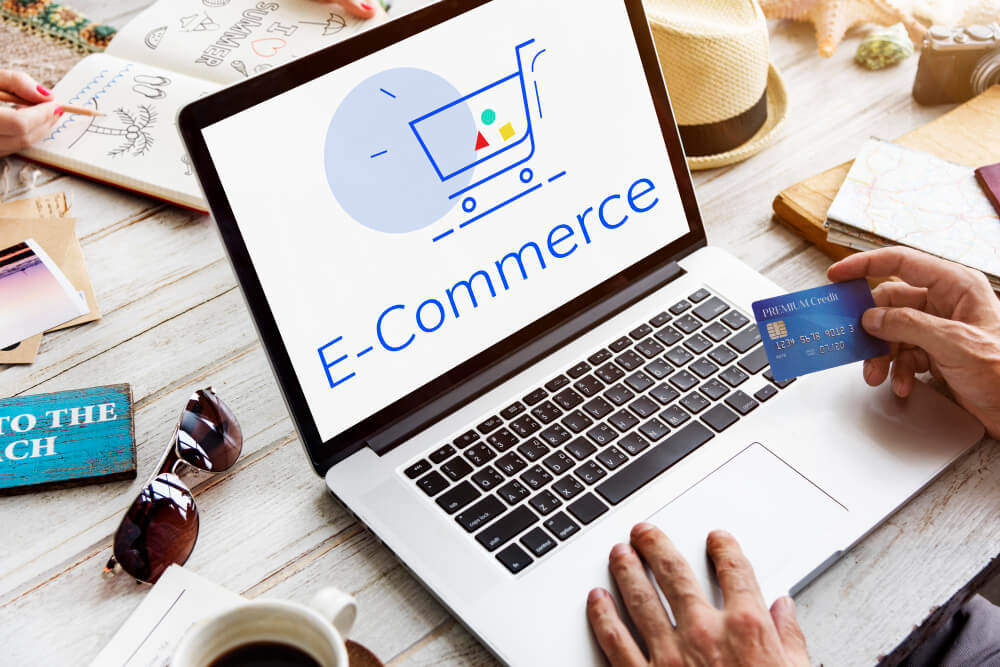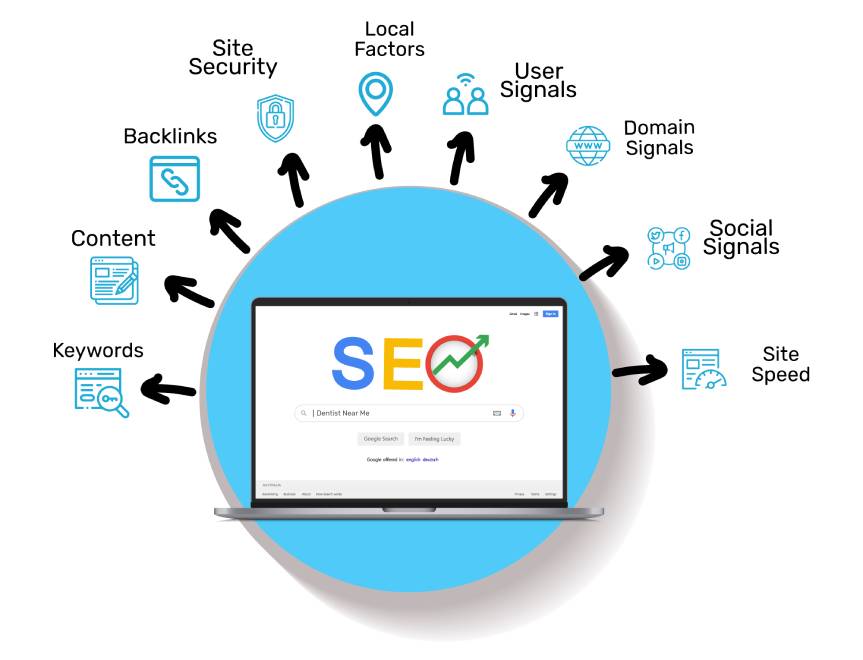Ecommerce Website Development Cost: How Much Does it Actually Cost in 2024
August 31, 2024 | Ecommerce, Pricing, Website Development
Planning to build an ecommerce website for your shop but not sure how much does it cost to build an e-commerce website in 2024? You have come to the right page. Must read this blog to know the ecommerce website development cost in 2024.
What is Ecommerce Actually?

Ecommerce, short for electronic commerce, refers to the buying and selling of goods and services over the internet. It involves conducting business transactions through electronic means, primarily online platforms. Ecommerce encompasses a wide range of activities, from online shopping and electronic payments to internet banking, digital marketing, and supply chain management. The essence of ecommerce lies in the electronic exchange of value, whether it’s products, services, or information.
Key components of ecommerce include:
- Online Retail (B2C):
- Business-to-Consumer (B2C) ecommerce is perhaps the most well-known form, where businesses sell products or services directly to end consumers. Examples include online retailers like Amazon, eBay, and various brand websites.
- Online Marketplaces:
- Online marketplaces serve as platforms that bring together multiple sellers and buyers. These platforms facilitate transactions between different parties. Examples include Etsy, Alibaba, and eBay.
- Electronic Payments:
- Ecommerce relies heavily on electronic payment systems to facilitate transactions. Credit cards, digital wallets, and other online payment methods enable secure and efficient financial transactions over the internet.
- Digital Marketing:
- Ecommerce businesses use digital marketing strategies to promote their products or services online. This includes activities such as search engine optimization (SEO), social media marketing, email marketing, and online advertising.
- Supply Chain and Logistics:
- Efficient supply chain management is crucial in ecommerce. This involves inventory management, order fulfillment, and shipping logistics to ensure timely and accurate delivery of products to customers.
- Business-to-Business (B2B) Ecommerce:
- B2B ecommerce involves transactions between businesses. Companies buy and sell goods or services to each other through online platforms, streamlining the procurement process.
- Mobile Commerce (M-Commerce):
- With the increasing use of smartphones, mobile commerce has gained prominence. M-commerce refers to ecommerce transactions conducted through mobile devices, such as smartphones and tablets.
- Online Banking and Finance:
- Ecommerce extends to online banking and financial services. Users can perform banking transactions, manage investments, and conduct financial activities through secure online platforms.
- Subscription Services:
- Many businesses offer subscription-based services through ecommerce models. This includes streaming services, software subscriptions, and monthly product subscriptions.
Ecommerce has transformed the way businesses operate and consumers shop, providing convenience, accessibility, and a global reach. It continues to evolve with advancements in technology, shaping the future of commerce and influencing various industries. The growth of ecommerce has been particularly significant in the digital age, with consumers and businesses alike embracing the benefits of online transactions and electronic commerce.
A. Importance of Ecommerce Websites

Ecommerce websites have become integral to the modern business landscape, playing a pivotal role in the way companies operate and consumers shop. The importance of ecommerce websites can be highlighted through various key aspects:
- Global Reach:
- Ecommerce enables businesses to reach a global audience without the constraints of physical locations. Companies can expand their market reach beyond geographical boundaries and tap into diverse consumer segments.
- Convenience for Consumers:
- Ecommerce provides unparalleled convenience for consumers. With 24/7 accessibility, customers can shop at any time, from anywhere, making the purchasing process more flexible and accommodating to their schedules.
- Increased Sales Opportunities:
- Ecommerce platforms open up additional sales channels for businesses. Beyond brick-and-mortar stores, companies can leverage online platforms to increase sales, attract new customers, and promote products and services effectively.
- Cost-Efficiency:
- Operating an ecommerce website is often more cost-effective than maintaining a physical store. Businesses can save on expenses related to rent, utilities, and staff required for a traditional storefront, allowing them to allocate resources more efficiently.
- Data-Driven Insights:
- Ecommerce platforms generate valuable data and analytics. Businesses can gain insights into customer behavior, preferences, and trends, allowing for data-driven decision-making. This information is crucial for refining marketing strategies and improving the overall customer experience.
- Personalization and Targeted Marketing:
- Ecommerce websites enable personalized experiences for users. Through data analysis, businesses can tailor product recommendations, marketing messages, and promotions to individual customer preferences, enhancing engagement and satisfaction.
- Reduced Barriers to Entry:
- Ecommerce reduces barriers to entry for small and medium-sized businesses. Setting up an online store is more accessible and affordable than establishing a physical storefront, enabling entrepreneurs to enter the market with relative ease.
- Enhanced Customer Experience:
- Ecommerce websites allow businesses to provide a seamless and user-friendly experience. Features such as easy navigation, secure payment gateways, and responsive design contribute to a positive customer experience, fostering loyalty and repeat business.
- Adaptation to Changing Consumer Trends:
- Ecommerce is adaptable to evolving consumer trends. With the rise of mobile shopping, social commerce, and other technological advancements, ecommerce platforms can quickly integrate new features and functionalities to meet changing consumer preferences.
- Improved Brand Visibility:
- An ecommerce presence enhances brand visibility. With effective online marketing strategies, businesses can build a strong online presence, attract a larger audience, and compete more effectively in the digital marketplace.
The importance of ecommerce websites lies in their ability to revolutionize the way businesses operate, connect with consumers, and adapt to the dynamic nature of the modern marketplace. Embracing ecommerce is not just a trend; it is a strategic imperative for businesses seeking sustainable growth and success in the digital age.
A Detailed overview on Ecommerce website development platform and their costs
Ecommerce website development platforms offer a range of options for businesses to create and manage their online stores. Each platform has its features, advantages, and associated costs. Below is a detailed overview of some popular ecommerce platforms and their cost considerations:
1. Shopify:

- Overview:
- Hosted solution with an easy-to-use interface.
- Suitable for small to medium-sized businesses.
- Provides a variety of themes and apps for customization.
- Costs:
- Subscription Fee: Starting from $29 per month for the Basic Shopify plan.
- Transaction Fees: Charged for each transaction unless using Shopify Payments.
Also Read: How Much Does Shopify Website Development Cost in 2024?
2. WooCommerce (WordPress):

- Overview:
- Open-source plugin for WordPress.
- Highly customizable and scalable.
- Suited for businesses of all sizes.
- Costs:
- Plugin: Free to download and use.
- Hosting: Costs vary; shared hosting can start from $5 to $20 per month.
- Themes and Extensions: Costs vary based on chosen options.
3. Magento:

- Overview:
- Open-source or enterprise version available.
- Ideal for medium to large enterprises.
- Highly customizable and scalable.
- Costs:
- Community Edition (Open Source): Free to use, but development costs apply.
- Enterprise Edition: Pricing is typically based on business size; contact Magento for a quote.
- Hosting: Costs vary based on the hosting provider.
Also Read: Understanding Magento Website Development Costs: A Comprehensive Guide
4. BigCommerce:
![]()
- Overview:
- Hosted solution with a focus on scalability.
- Suitable for small to large businesses.
- All-in-one platform with built-in features.
- Costs:
- Subscription Fee: Starting from $29.95 per month.
- Transaction Fees: No transaction fees with built-in payment gateways.
- Additional Costs: App fees may apply for third-party integrations.
5. Wix Ecommerce:

- Overview:
- Website builder with ecommerce capabilities.
- Suitable for small to medium-sized businesses.
- Drag-and-drop interface for easy customization.
- Costs:
- Ecommerce Plan: Starting from $23 per month.
- Transaction Fees: None for online payments.
- Additional Costs: App fees may apply for premium features.
Also Read: WIX Website Development Cost: Benefits, Features & How Much Does it Cost? —
6. Squarespace:

- Overview:
- Website builder with integrated ecommerce features.
- Suited for small to medium-sized businesses.
- Templates designed for a visually appealing online store.
- Costs:
- Business Plan: Starting from $18 per month.
- Transaction Fees: None for online payments.
- Additional Costs: App fees may apply for extra features.
Also Read: Squarespace Website Development Cost: Features, Plans & Costs Involved
7. Volusion:
- Overview:
- Hosted ecommerce platform.
- Suitable for small to medium-sized businesses.
- Offers built-in tools for managing inventory and orders.
- Costs:
- Subscription Fee: Starting from $29 per month.
- Transaction Fees: None with in-house payment gateway.
- Additional Costs: Extra fees for premium features or apps.
8. PrestaShop:
- Overview:
- Open-source ecommerce platform.
- Suited for small to medium-sized businesses.
- Highly customizable and extensible.
- Costs:
- Platform: Free to use, but development costs apply.
- Hosting: Costs vary based on the hosting provider.
- Themes and Modules: Costs vary based on chosen options.
9. OpenCart:
- Overview:
- Open-source ecommerce platform.
- Suitable for small to medium-sized businesses.
- Offers a straightforward and user-friendly interface.
- Costs:
- Platform: Free to use, but development costs apply.
- Hosting: Costs vary based on the hosting provider.
- Extensions and Themes: Costs vary based on chosen options.
10. Drupal Commerce:
- Overview:
- Open-source ecommerce framework for Drupal.
- Suited for medium to large enterprises.
- Offers flexibility and scalability.
- Costs:
- Platform: Free to use, but development costs apply.
- Hosting: Costs vary based on the hosting provider.
- Modules and Themes: Costs vary based on chosen options.
Important Considerations for Cost Estimation:
- Customization: The more customization you require, the higher the development costs.
- Hosting: Hosting costs vary based on the platform and hosting provider.
- Themes and Extensions: Premium themes and extensions may have additional costs.
- Transaction Fees: Some platforms charge transaction fees, while others do not.
When selecting an ecommerce platform, consider your business needs, budget, and desired level of customization. It’s also crucial to account for ongoing costs such as hosting, maintenance, and potential upgrades.
Features an Ecommerce Website Must Have in 2024

As technology and user expectations continue to evolve, ecommerce websites must stay updated with the latest features to provide a competitive and compelling online shopping experience. In 2024, some essential features for an ecommerce website include:
- Mobile Optimization:
-
- With an increasing number of users shopping on mobile devices, ensuring a seamless and user-friendly mobile experience is crucial.
- Progressive Web App (PWA):
-
- PWAs offer improved performance and offline capabilities, providing a more app-like experience for users without the need for a separate download.
- Voice Search Integration:
-
- Integrating voice search functionality allows users to search for products and navigate the website using voice commands, catering to the growing trend of voice-activated technology.
- Augmented Reality (AR) for Product Visualization:
-
- AR features enable customers to virtually try out products before purchasing, enhancing the online shopping experience for items like clothing, accessories, and furniture.
- Personalization and AI Recommendations:
-
- Implementing artificial intelligence for personalized product recommendations based on user behavior, purchase history, and preferences.
- Real-time Customer Support:
-
- Providing live chat, chatbots, or virtual assistants for real-time customer support, addressing queries, and offering assistance during the shopping process.
- Subscription Services and Loyalty Programs:
-
- Offering subscription-based services and loyalty programs to encourage repeat business and reward loyal customers.
- Multi-Channel Selling:
-
- Expanding beyond the website by integrating with social media platforms and online marketplaces to reach a wider audience.
- Blockchain for Secure Transactions:
-
- Integrating blockchain technology to enhance security and transparency in online transactions, providing a secure environment for financial transactions.
- Social Commerce Integration:
-
- Leveraging social media platforms for seamless shopping experiences directly within social apps, making it easier for users to discover and purchase products.
- Flexible Payment Options:
-
- Providing a variety of payment options, including digital wallets, buy now, pay later (BNPL), and cryptocurrency, to cater to diverse customer preferences.
- Advanced Analytics and Data Insights:
-
- Utilizing advanced analytics tools to gather and analyze customer data for better decision-making, personalized marketing strategies, and improved user experiences.
- Green and Sustainable Practices:
-
- Highlighting eco-friendly and sustainable practices, such as carbon-neutral shipping options, to appeal to environmentally conscious consumers.
- Dynamic Pricing:
-
- Implementing dynamic pricing strategies based on real-time market demand, inventory levels, and customer behavior to optimize pricing and promotions.
- AR-powered Virtual Try-Ons:
-
- Extending AR capabilities to allow users to virtually try on products like apparel, accessories, and cosmetics before making a purchase.
- Enhanced Security Measures:
-
- Strengthening security measures to protect customer data, including two-factor authentication, biometric authentication, and robust encryption protocols.
- Voice Commerce:
-
- Enabling voice-activated purchasing through virtual assistants or smart devices, providing a hands-free shopping experience.
- Social Proof and User-Generated Content:
-
- Incorporating user reviews, ratings, and user-generated content to build trust and credibility among potential buyers.
By incorporating these features, ecommerce websites can stay ahead of the curve, meet customer expectations, and provide a cutting-edge shopping experience in 2024. It’s essential for businesses to adapt to emerging trends and technologies to remain competitive in the rapidly evolving ecommerce landscape.
SEO features an ecommerce website must have?

Implementing strong SEO (Search Engine Optimization) features is essential for the success of an ecommerce website. Here are crucial SEO features that an ecommerce site should have:
- Keyword Research: Conduct thorough keyword research to identify relevant and high-volume keywords related to your products. Use tools like Google Keyword Planner to find keywords with good search volumes and low competition.
- SEO-Friendly URLs: Create clean, descriptive, and user-friendly URLs for product pages. Include the target keyword and avoid using generic or automated URLs.
- Unique Meta Titles and Descriptions: Craft unique and compelling meta titles and descriptions for each product page. Ensure they are within the recommended character limits and include relevant keywords to attract clicks from search engine results.
- Product Schema Markup: Implement product schema markup to provide search engines with structured information about your products. This can enhance the visibility of rich snippets in search results.
- Optimized Product Images: Optimize product images by using descriptive file names and adding alt text. Compress images to improve page load times, which can positively impact SEO.
- Mobile Optimization: Ensure that your ecommerce website is mobile-friendly. Google prioritizes mobile-friendly websites, and a responsive design improves the user experience on various devices.
- Site Speed Optimization: Optimize your website for fast loading times. Compress images, leverage browser caching, and minimize server response times to improve overall site speed.
- Canonical Tags: Use canonical tags to prevent duplicate content issues, especially for product pages that may have different URLs due to sorting or filtering options.
- Internal Linking: Implement a logical internal linking structure. Link relevant product pages to each other using descriptive anchor text. This helps distribute link equity and improves navigation for users and search engines.
- XML Sitemap: – Create and submit an XML sitemap to search engines. A sitemap helps search engines understand the structure of your site and index pages more efficiently.
- SSL Certificate: Secure your ecommerce site with an SSL certificate. Google considers HTTPS as a ranking factor, and it helps build trust with users by securing their data during transactions.
- User Reviews and Ratings: Encourage and showcase user reviews and ratings. Positive reviews can improve click-through rates and build credibility, which can indirectly impact SEO.
- Social Media Integration: Integrate social media sharing buttons and encourage social sharing. While social signals are not direct ranking factors, social media can contribute to increased visibility and traffic.
- Breadcrumb Navigation: Implement breadcrumb navigation to enhance the user experience and provide search engines with a clear hierarchy of your site’s structure.
- 404 Page Optimization: Create a custom 404 error page with links to key sections of your site. This helps retain visitors who may encounter broken links.
- Robots.txt File: Use a robots.txt file to control search engine crawlers’ access to certain pages of your site. Ensure that important pages are crawlable, while irrelevant or sensitive pages are restricted.
- Regular Content Updates: Keep your website’s content updated. Regularly adding new products, blog posts, or other content signals to search engines that your site is active and relevant.
- Canonicalization of Product Variations: If you have multiple variations of a product (e.g., different colors or sizes), use canonical tags to consolidate their SEO value and avoid duplicate content issues.
- 404 Error Monitoring: Implement a system to monitor 404 errors and address them promptly. Regularly check for broken links and redirect them to relevant pages to maintain a positive user experience.
- Local SEO Optimization (if applicable): If you have physical stores or serve specific geographic locations, optimize your site for local SEO. This includes creating local business listings, obtaining customer reviews, and providing accurate contact information.
Implementing these SEO features will contribute to better visibility on search engines, improved user experience, and increased chances of attracting and converting organic traffic on your ecommerce website. Regular monitoring and adjustments based on SEO best practices and algorithm updates are essential for long-term success.
What is the scope of ecommerce websites?

The scope of e-commerce websites is broad and encompasses various aspects, including:
- Retail and Wholesale:
- Selling products directly to consumers (B2C) or other businesses (B2B).
- Managing product catalogs, inventory, pricing, and promotions.
- Marketplaces:
- Platforms where multiple vendors can sell their products or services, like Amazon or eBay.
- Facilitating transactions, handling logistics, and providing customer service.
- Digital Products and Services:
- Selling digital goods such as e-books, software, music, and online courses.
- Offering subscription-based services like streaming, SaaS (Software as a Service), and memberships.
- Payment Processing:
- Integrating secure payment gateways for credit/debit cards, digital wallets, and other payment methods.
- Ensuring compliance with financial regulations and data security standards (e.g., PCI DSS).
- Customer Management:
- Implementing customer relationship management (CRM) systems.
- Personalizing user experiences and managing customer accounts, orders, and support.
- Marketing and SEO:
- Utilizing digital marketing strategies like SEO, PPC, social media marketing, and email campaigns.
- Analyzing customer data to optimize marketing efforts and increase conversions.
- Logistics and Supply Chain Management:
- Coordinating the storage, packaging, and shipping of products.
- Integrating with third-party logistics providers and managing returns and exchanges.
- Analytics and Reporting:
- Tracking sales, traffic, and customer behavior using analytics tools.
- Generating reports to inform business decisions and strategy adjustments.
- Mobile Commerce:
- Ensuring the website is mobile-friendly and developing dedicated mobile apps.
- Leveraging mobile-specific features like push notifications and location-based services.
- Legal and Regulatory Compliance:
- Adhering to laws and regulations regarding e-commerce, consumer rights, data protection (e.g., GDPR), and taxation.
- User Experience (UX) and Design:
- Creating intuitive, visually appealing, and accessible website designs.
- Ensuring a seamless and enjoyable shopping experience for users.
- Technology and Infrastructure:
- Utilizing robust platforms and technologies to build and maintain the e-commerce site.
- Ensuring site security, scalability, and performance.
These aspects collectively determine the success and efficiency of e-commerce websites, influencing how businesses interact with customers and manage their operations online.
Benefits of building an ecommerce website for store owners?
Building an e-commerce website offers numerous benefits for store owners, including:
- Increased Reach:
- Access to a global customer base, breaking geographical limitations.
- Ability to attract customers from various regions and markets.
- Lower Operating Costs:
- Reduced overhead compared to physical stores (e.g., rent, utilities).
- Lower staffing requirements with automated processes and self-service options for customers.
- 24/7 Availability:
- Ability to make sales and engage with customers at any time, increasing convenience and sales potential.
- Continuous operation without the constraints of physical store hours.
- Improved Customer Insights:
- Access to detailed analytics on customer behavior, preferences, and purchasing patterns.
- Ability to use data for targeted marketing, personalized experiences, and informed decision-making.
- Enhanced Marketing Opportunities:
- Utilization of digital marketing tools and strategies such as SEO, PPC, email marketing, and social media.
- Opportunities for cost-effective advertising and broader audience reach.
- Scalability and Growth:
- Easier to scale operations and manage increased demand without significant infrastructure changes.
- Ability to quickly add new products, categories, and features to meet market trends and customer needs.
- Better Customer Experience:
- Offering a convenient and seamless shopping experience with features like easy navigation, product recommendations, and customer reviews.
- Providing multiple payment options and streamlined checkout processes.
- Direct Customer Interaction:
- Building a direct relationship with customers without intermediaries.
- Collecting feedback, handling inquiries, and offering support to improve customer satisfaction.
- Competitive Advantage:
- Staying ahead of competitors by leveraging advanced technologies and innovative solutions.
- Differentiating the brand with unique online experiences and offerings.
- Inventory and Order Management:
- Efficiently managing inventory with real-time updates and automated tracking.
- Simplifying order processing and fulfillment, reducing errors and improving efficiency.
- Flexibility and Customization:
- Tailoring the website to reflect the brand’s identity and values.
- Offering customized shopping experiences based on customer preferences and behaviors.
- Environmental Impact:
- Reducing the need for physical stores, thereby decreasing the carbon footprint associated with construction and maintenance.
- Promoting sustainable practices with digital products and paperless transactions.
- Adaptability to Trends:
- Quickly adapting to market trends and customer demands with agile business practices.
- Experimenting with new business models, such as subscription services, drop shipping, or virtual consultations.
Overall, building an e-commerce website enables store owners to expand their market presence, optimize operations, enhance customer engagement, and drive business growth in a cost-effective manner.
Ecommerce website development cost depending on Website size, type and design and development
The cost of developing an e-commerce website can vary widely based on several factors including the website size, type, design, and development requirements. Here’s a breakdown of these factors and their impact on the cost:
Website Size
Small E-commerce Websites:
- Description: Typically fewer than 100 products, simple navigation, basic features.
- Cost Range: $2,000 – $10,000
- Details: Basic product catalog, standard payment integration, essential security features, simple design.
Medium E-commerce Websites:
- Description: Between 100 to 1,000 products, more complex navigation, additional features.
- Cost Range: $10,000 – $50,000
- Details: Advanced product filters, multiple payment gateways, enhanced security, more intricate design, user accounts, customer reviews, basic CRM and inventory management integration.
Large E-commerce Websites:
- Description: Over 1,000 products, complex navigation and functionality.
- Cost Range: $50,000 – $100,000+
- Details: Comprehensive product management, high-level customization, multiple integrations (ERP, CRM, advanced inventory management), sophisticated user experience, advanced security measures.
Website Type
Product-based E-commerce:
- Description: Focus on physical or digital products.
- Cost Range: $5,000 – $50,000
- Details: Varies based on product range, customization of product pages, and features like wishlists, reviews, and recommendations.
Service-based E-commerce:
- Description: Selling services rather than products.
- Cost Range: $3,000 – $20,000
- Details: Booking systems, service descriptions, customer testimonials, payment integrations tailored for services.
Marketplace E-commerce:
- Description: Platforms like Amazon or eBay where multiple vendors sell products.
- Cost Range: $20,000 – $100,000+
- Details: Vendor management, complex search and filtering options, multiple payment options, extensive security measures, vendor rating systems.
Design and Development
Basic Design and Development:
- Description: Simple, pre-designed templates with minimal customization.
- Cost Range: $2,000 – $10,000
- Details: Basic themes, standard features, limited customization options, suitable for small businesses or startups.
Moderate Design and Development:
- Description: Custom-designed themes with moderate functionality and features.
- Cost Range: $10,000 – $50,000
- Details: Unique branding, more custom features, better user experience, mobile responsiveness, SEO optimization, integration with third-party tools.
Advanced Design and Development:
- Description: Highly customized design and development with extensive features and integrations.
- Cost Range: $50,000 – $100,000+
- Details: Completely bespoke design, high-level customization, advanced features (AI recommendations, complex filtering), integration with multiple third-party systems (ERP, CRM, analytics), enhanced performance optimization, and security.
Additional Cost Factors
Payment Gateway Integration:
- Description: Integrating multiple and secure payment options.
- Cost Range: $500 – $5,000+
- Details: Varies based on the number of gateways and complexity of integration.
Security Features:
- Description: SSL certificates, encryption, fraud detection, and compliance with regulations like PCI DSS and GDPR.
- Cost Range: $1,000 – $10,000+
- Details: Basic security measures are cheaper, but robust, comprehensive security setups will cost more.
Mobile Responsiveness:
- Description: Ensuring the website works seamlessly on mobile devices.
- Cost Range: $1,000 – $10,000+
- Details: Cost depends on the level of responsiveness required and whether a separate mobile site or app is developed.
Maintenance and Support:
- Description: Ongoing support and updates to keep the website secure and functional.
- Cost Range: $500 – $5,000/month
- Details: Includes security updates, feature enhancements, bug fixes, and possibly content updates.
Marketing and SEO:
- Description: Implementing SEO strategies and digital marketing tools.
- Cost Range: $1,000 – $10,000+
- Details: Costs depend on the extent of SEO work and the integration of marketing tools like email marketing, social media, and PPC campaigns.
When budgeting for an e-commerce website, it’s important to consider not only the initial development costs but also ongoing maintenance and potential upgrades as your business grows.
Alok Kumar
I am a seasoned digital marketing expert with over 10 years of experience in the field. My passion for digital marketing and optimization began in 2012 where i started learning and developed a keen interest in search engine algorithms and their impact on online businesses.
Throughout my career, I have helped numerous companies increase their online visibility, drive traffic, and generate leads through effective digital marketing strategies. I have worked with businesses of all sizes, from small startups to large corporations, across a variety of industries.

Latest Articles







